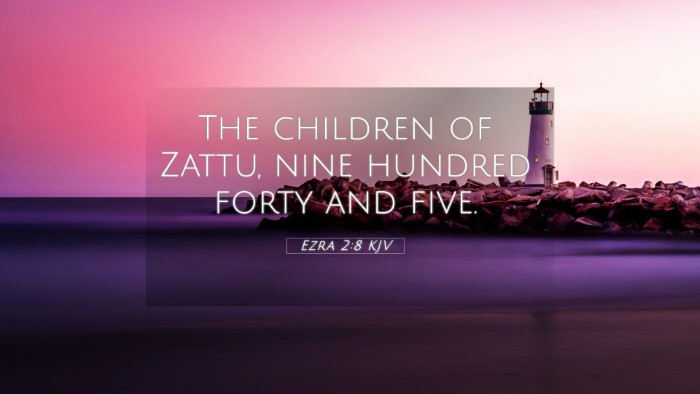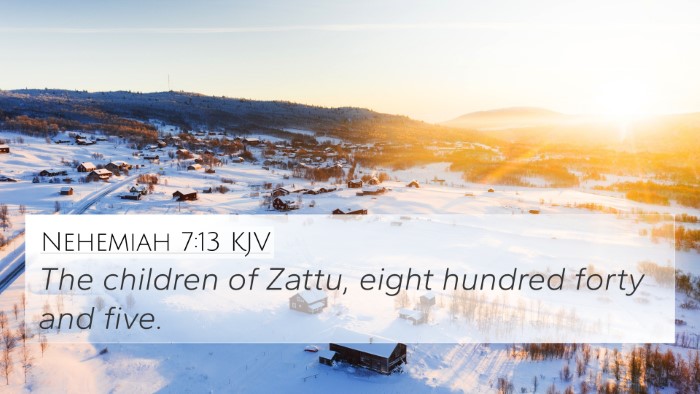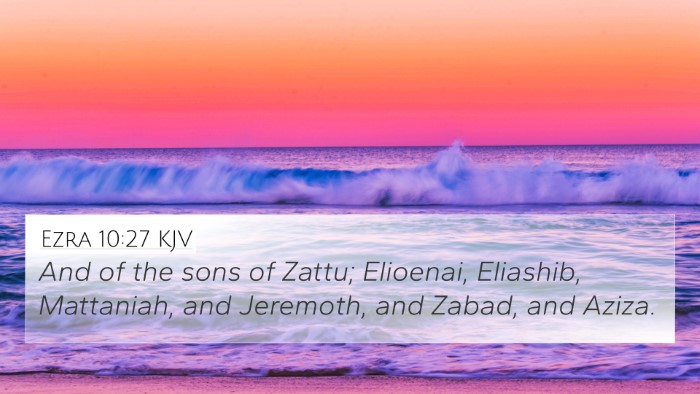Understanding Ezra 2:8
In Ezra 2:8, we read: "The children of Parosh, two thousand an hundred seventy and two." This verse forms part of a larger list detailing the exiles who returned from Babylon to Jerusalem. It highlights the organized nature of this return from exile and serves to affirm the continuity of God's people.
Contextual Overview
The context of Ezra 2 revolves around the significant theme of restoration after exile. Here, the descendants of various tribes and families are enumerated, marking a crucial step in the rebuilding of the community and the temple in Jerusalem. Commentaries suggest that this listing serves both a historical and spiritual purpose, emphasizing God's faithfulness to His covenant people.
Commentary Insights
Matthew Henry's Commentary
Matthew Henry emphasizes the importance of names and numbers in scripture as they reflect God's providence and the fulfillment of His promises. He remarks on the fact that the returnees, including the children of Parosh, were counted as part of a divine plan, illustrating how God preserved a remnant from Babylonian captivity. The notable number of 2,172 indicates both the significance of this group and God's ability to restore His people.
Albert Barnes' Notes on the Bible
Albert Barnes notes that the inclusion of families and their numbers provides a sense of order and structure to what could otherwise be perceived as chaos post-exile. He observes that this particular verse emphasizes the contribution of the tribe of Parosh to the overall restoration, a reminder of how each family contributes to the whole community's revival.
Adam Clarke's Commentary
Adam Clarke takes a deeper look at the significance of the tribe of Parosh, suggesting that their return signifies hope and rebuilding. He elaborates on the importance of understanding the original Hebrew text, shedding light on the cultural and historical implications of such returns in that period. His analysis compels readers to observe that these returns are not mere statistics but stories of individuals restoring their identities and heritage.
Thematic analysis and Cross-references
Connecting Ezra 2:8 with other scriptures offers insights into God's plan and the importance of community in worship and restoration.
- Nehemiah 7:8: This verse parallels Ezra's account by recounting the families returning to Jerusalem, affirming God's continuity in the rebuilding effort.
- 1 Chronicles 9:3: Chronicles records names similar to those in Ezra, linking the historical accounts of the tribes as essential for community identity.
- Isaiah 11:12: The gathering of God's people from the nations signifies God's salvific work, tying directly into the theme of restoration seen in Ezra.
- Jeremiah 29:10: The promise of a return after 70 years of captivity resonates with the realization outlined in Ezra 2, highlighting God's faithfulness to His promises.
- Ezekiel 37:21: The promise to bring the Israelites back to their land connects to the narrative of Ezra, underscoring God's redemptive plan for His people.
- Luke 4:18-19: Jesus’ mission mirrors the restoration themes present in Ezra, fulfilling the prophetic declarations of returning wholeness.
- Romans 11:1-2: Paul speaks of God's chosen people, indicating continuity in God’s plan for Israel, as evidenced in the list of returning exiles.
- Galatians 3:29: There is a New Testament connection where believers, as children of God, reflect the ongoing theme of restoration, just as the exiles in Ezra’s time.
- Revelation 7:4-8: The vision of God's people in Heaven is reminiscent of the return of the exiles, showing the culmination of God's redemptive history.
- Matthew 2:23: The reference of Jesus living in Nazareth as fulfillment connects back to the lineage and restoration seen in Ezra, emphasizing God’s sovereign hand in history.
Practical Applications
For modern readers, understanding Ezra 2:8 allows for a broader reflection on restoration and community. It encourages believers today to acknowledge their heritage in faith, to recognize the significance of individual contributions to the body of Christ, and to celebrate the continuity of God’s plan through generations.
Conclusion
Ezra 2:8 serves not only as a historical record but as a meaningful representation of God's faithfulness to His people. By cross-referencing with other biblical texts, believers can gain a deeper understanding of the themes of restoration, hope, and community that transcend time, making this exploration key to both personal faith and collective worship.




